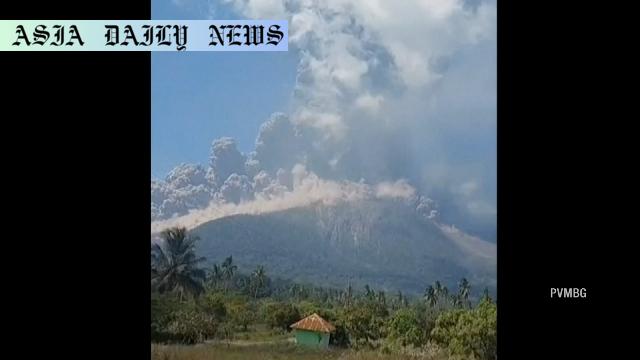Volcanic Eruption – Indonesian volcano erupts, Mount Lewotobi Laki Laki’s ash cloud reaches 19 kilometers, no tsunami concerns in Japan.
Indonesia’s Mount Lewotobi Laki Laki erupts again with a 19-kilometer-high ash cloud.
The eruption had no observed impact on Japan’s tidal levels, confirming no tsunami concerns.
Mount Lewotobi’s history includes recent eruptions causing casualties in November and follow-ups in March and June.

Introduction
Indonesia’s Mount Lewotobi Laki Laki has erupted once again, causing a dramatic 19-kilometer-high ash plume to rise amid concerns of potential geological fallout. While volcanic eruptions are not uncommon in this region, this particular instance has drawn significant attention due to its magnitude and past incidents of devastation associated with the mountain. Fortunately, Japanese officials have confirmed that no tsunami was triggered as a result of the eruption. This outcome may come as a relief to many, but the persistent activity of Mount Lewotobi serves as a strong reminder of the forces of nature and the challenges faced by communities living near these geological hotspots.
Details of the Eruption
Mount Lewotobi Laki Laki erupted at approximately 11 a.m. local time on Monday, according to Indonesia’s volcano monitoring agency. The ash cloud, a towering mass of volcanic material, reached an astonishing height of 19 kilometers above the summit, posing significant risks to air travel and local environments. This eruption is one of several in recent months, with notable prior events occurring in November, March, and June. During one of these eruptions in November, casualties were reported, further emphasizing the perilous nature of this volcanic activity.
Japan’s Monitoring and Response
The Japan Meteorological Agency, which monitors seismic and volcanic activity with acute sensitivity, reported no changes in tidal levels in or outside Japan’s observation points. This confirmation ensures that no tsunami waves were triggered, a scenario that is often a secondary concern following underwater eruptions or significant geological movements near coastal regions. Japan’s vigilance in monitoring volcanic activity in the region not only underscores its technological capabilities but also highlights the collaborative nature of regional crisis management.
A History of Eruptions
Mount Lewotobi Laki Laki has earned a reputation for its recurring eruptions, which have directly impacted local communities and global weather patterns. The November eruption, in particular, led to casualties and brought attention to the preparedness of both local and national emergency response teams. Additional episodes in March and June this year have reinforced the mountain’s status as a potent reminder of Indonesia’s position along the Pacific Ring of Fire, a region characterized by frequent volcanic eruptions and earthquakes.
Lessons and Preparedness
For communities in Indonesia, Mount Lewotobi serves as both a natural landmark and a source of concern. Preparing for volcanic activity involves not only monitoring but also educating the public about evacuation routes, emergency protocols, and long-term risk mitigation strategies. Regional governments and international partners regularly collaborate to improve disaster response frameworks, ensuring that casualties and infrastructure damage are minimized.
The Global Perspective
Natural disasters such as volcanic eruptions remind us of the interconnectedness of our world. While the eruption of Mount Lewotobi primarily affects Indonesia, the ripple effects—including air traffic disruptions and potential climate impacts—have global implications. International cooperation in monitoring and responding to such events highlights the importance of shared knowledge, advanced technology, and humanity’s collective resilience in the face of natural challenges.
Conclusion
Despite the lack of tsunami concerns in Japan, the eruption of Mount Lewotobi Laki Laki is a stark reminder of nature’s unpredictable power. By continuing to develop advanced monitoring systems, fostering international collaboration, and implementing robust disaster preparedness measures, humanity can better navigate the challenges posed by the natural world. The people of Indonesia, with their resilience and resourcefulness, demonstrate how communities can coexist with immense natural phenomena while working to safeguard lives and livelihoods.



Commentary
The Power and Unpredictability of Nature
The eruption of Mount Lewotobi Laki Laki underscores the breathtaking power and unpredictability of nature. Watching a towering ash cloud ascend 19 kilometers into the sky evokes both awe and concern. Such events remind us of our vulnerability as inhabitants of this planet, constantly at the mercy of geological forces beyond our control. They also showcase the indomitable resilience of communities living near volatile regions, who persist despite the looming threats posed by these natural phenomena.
Human Preparedness vs. Nature’s Fury
What stands out in this incident is not only the scale of the eruption but also the thorough preparedness of monitoring agencies such as those in Indonesia and Japan. The restraint in damage caused and the absence of a tsunami are testaments to years of rigorous observation and technological advancements. However, these successes should not lead to complacency. It is imperative that all stakeholders—governments, local communities, and international organizations—continue investing in research, disaster management, and public education to minimize risks during future eruptions.
A Global Reflection
On a larger scale, this eruption serves as a poignant reminder of the importance of global cooperation. Whether it’s ensuring timely communication of seismic data or responding to potential climate impacts, the interdependence of nations becomes evident during such crises. For instance, Japan’s monitoring of tidal levels reflects a commitment to regional safety that goes beyond its borders. It’s a reflection of the shared responsibility humanity must embrace in the face of such challenges.
Conclusion
As Mount Lewotobi Laki Laki settles after its latest eruption, the lessons drawn from this event resonate far and wide. The balance between respecting the forces of nature and ensuring human safety is delicate, yet vital. By fostering a spirit of resilience, advancing scientific knowledge, and embracing global solidarity, we can navigate the uncertainties posed by our dynamic Earth.